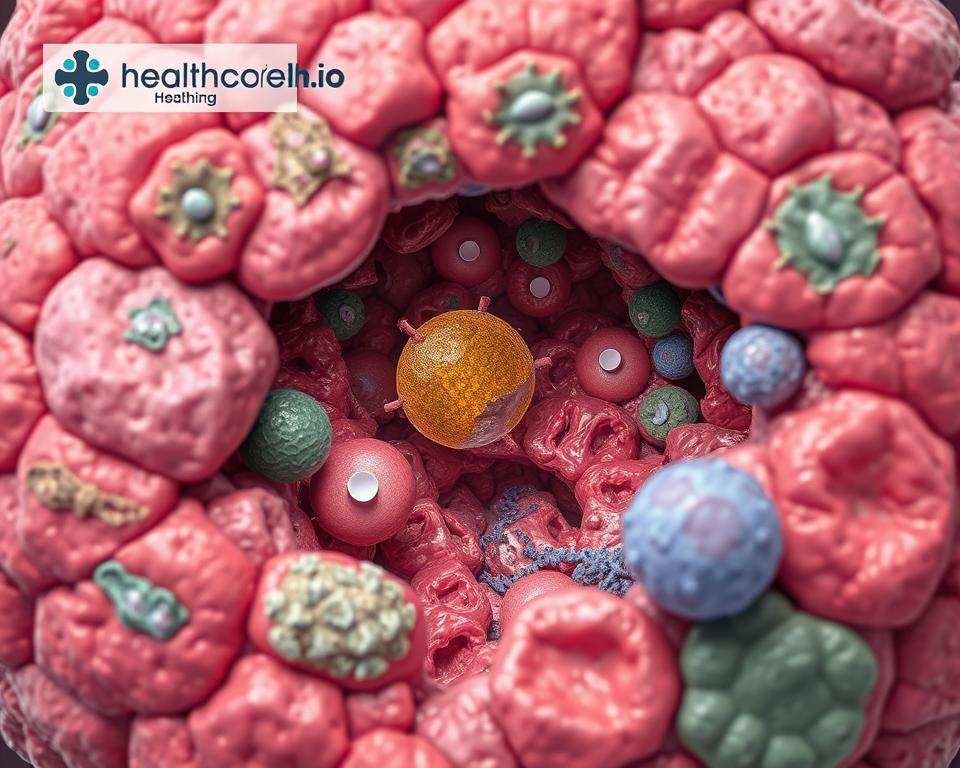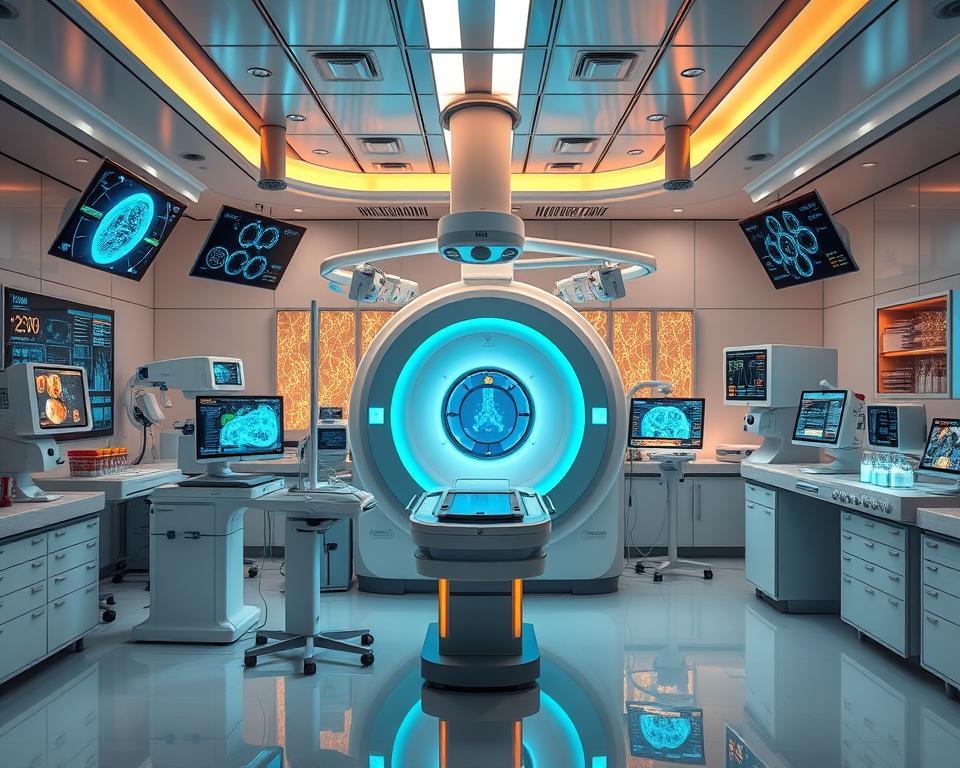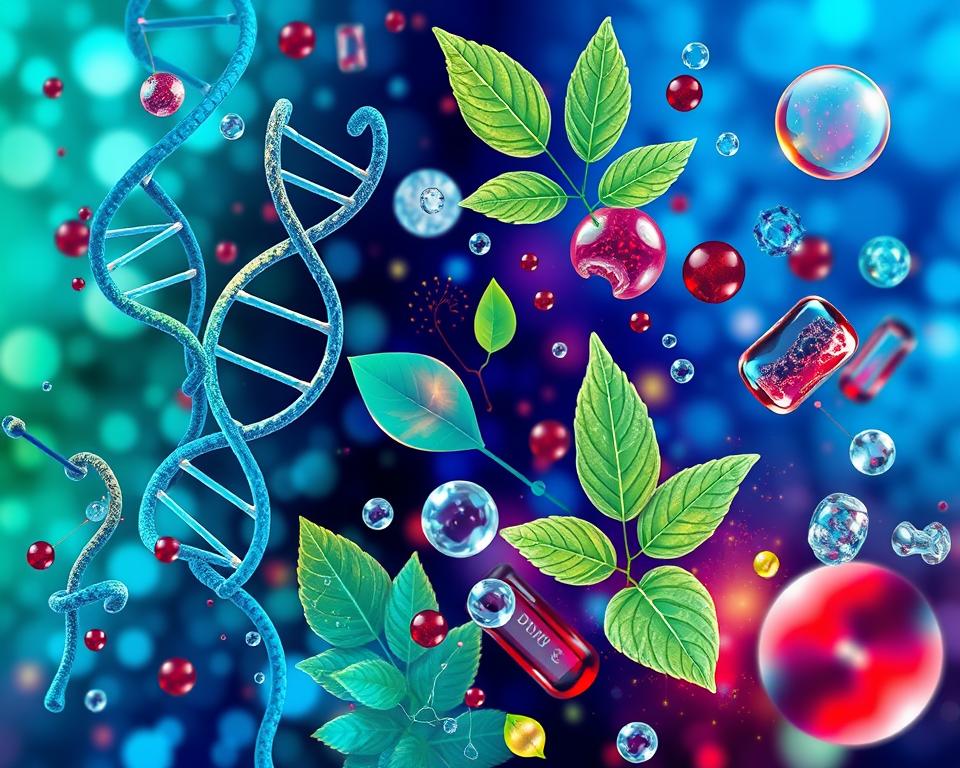The tumor microenvironment is a complex system that greatly affects cancer. It influences how cancer grows, spreads, and how it reacts to treatments. Knowing about this environment is key to finding better ways to diagnose and treat cancer.
This environment has many specific markers that can help in diagnosing and treating cancer. By studying it, scientists can learn more about how cancer starts and grows. This knowledge can lead to better care for those with cancer.
Key Takeaways
- The tumor microenvironment significantly influences cancer progression and treatment resistance.
- Cancer-associated fibroblasts are key in changing the environment around tumors and helping them grow blood vessels.
- Fibroblast activation protein is a promising target for diagnosing cancer.
- Understanding the tumor microenvironment is vital for creating effective treatments.
- The diversity of the tumor microenvironment offers many specific markers for targeted treatments.
- Studying the tumor microenvironment can provide insights into cancer, improving patient care.
Understanding the Tumor Microenvironment: A Complex Ecosystem
The tumor microenvironment (TME) is a complex system. It includes immune cells, stromal cells, blood vessels, and the extracellular matrix. Each part has its own role and how they work together affects tumor growth and spread.
The immune response is key in the TME. It can either help or hinder tumor growth, depending on the immune cells involved.
Research has found that cancer-associated fibroblasts (CAFs) play a big role in tumor progression. They change the extracellular matrix, help blood vessels grow, and weaken the immune system. This section will dive into the immune response and tumor progression in the TME.
Key Components and Their Roles
- Immune cells: promote or suppress tumor growth
- Stromal cells: modify the extracellular matrix and promote angiogenesis
- Blood vessels: supply nutrients and oxygen to the tumor
- Extracellular matrix components: provide structural support and influence cell behavior
Dynamic Interactions Within the Environment
The TME is full of complex interactions. These interactions create a unique environment that helps tumors grow and survive. Understanding these interactions is vital for finding new cancer treatments.
| Component | Role in TME |
|---|---|
| CAFs | Modify extracellular matrix, promote angiogenesis, and suppress immune responses |
| Immune cells | Promote or suppress tumor growth |
The Critical Role of Immune Cells in Tumor Progression
Immune cells are key in the fight against tumors. They interact with cancer cells and the tumor environment. This interaction is vital for understanding how to fight cancer.
T-cells, for example, can help or hinder the fight against cancer. Knowing how they work is important for finding new ways to treat cancer.
Studies show that certain immune cells can help patients live longer. But, other immune cells can help tumors grow. It’s a complex battle.
Several factors influence how immune cells act in tumors. For instance, some immune cells can be good or bad depending on their type. This is important for understanding how to treat cancer.
- TAMs polarization into M1 and M2 types, which affects tumor behavior
- Neutrophils transformation into tumor-associated neutrophils (TANs) classified into N1 (tumor suppressing) or N2 (tumor promoting) phenotypes
- Neutrophil-derived transforming growth factor-beta (TGF-β) induction of epithelial-mesenchymal transition (EMT) in lung cancer tissues
By studying these interactions, scientists can find new ways to fight cancer. More research is needed to fully understand the role of immune cells in cancer.
Stromal Cells and Their Impact on Cancer Growth
Stromal cells are key in the tumor microenvironment. They help cancer grow and spread. These cells, like fibroblasts and endothelial cells, work with cancer cells and others. Together, they form a complex system that can either help or hinder tumor growth.
Studies have found that cancer-associated fibroblasts (CAFs) are important in the tumor stroma. They help cancer develop and grow. CAFs have markers like fibroblast activation protein (FAP), which can be targeted for immunotherapy. Stromal cells play many roles in cancer growth, including changing the extracellular matrix and making new blood vessels.
Some ways stromal cells affect cancer growth include:
- Changing the extracellular matrix to help cancer cells move and invade
- Making new blood vessels to give the tumor oxygen and nutrients
- Being part of molecular pathways that help cancer cells grow and survive
Understanding stromal cells’ role in cancer is key for better immunotherapy. By targeting markers like FAP, we might stop cancer cells from growing. More research is needed to fully grasp how stromal cells and cancer cells interact. This will help us find effective treatments that target these interactions.
| Marker | Description |
|---|---|
| FAP | Fibroblast activation protein, a marker of cancer-associated fibroblasts |
| α-SMA | Alpha-smooth muscle actin, a marker of fibroblast activation |
Inflammation Patterns in Cancer Development
Inflammation is a complex response that can lead to cancer when it’s ongoing. Chronic inflammation raises the risk of cancer at the same site, studies show. It’s linked to about 20% of all cancers.
Research shows NSAIDs like aspirin can cut cancer risk by 30%. Also, canakinumab, which blocks IL-1β, lowers lung cancer risk by about 25%.
Factors that spark inflammation in tumors include infections and tissue damage. Oncogene activation and loss of tumor suppressor genes also play a role. Understanding inflammation patterns in cancer is key to finding new treatments.
People with chronic inflammation are 50% more likely to get certain cancers. Tumors with lots of T cells and anti-tumor immunity markers are more likely to respond to treatment.
Understanding Immune Evasion Mechanisms
Immune evasion is key in cancer growth. It lets tumor cells avoid the immune system and keep growing. Tumor cells release factors that stop immune cells from working. For instance, regulatory T cells can block the immune system’s fight against tumors.
Tumor cells use many ways to avoid the immune system. They can hide their antigens or make the immune system less effective. Factors like VEGF and IL-10 also help tumors by weakening the immune response.
Checkpoint Inhibition Processes
Checkpoint inhibition is a major way tumors evade the immune system. It happens when tumor cells express molecules like PD-L1. These molecules can stop immune cells from attacking by binding to PD-1.
Immunosuppressive Factors
Immunosuppressive factors, like TGF-β and IL-10, are important in immune evasion. They stop immune cells from working and help tumors grow. These factors come from tumor cells or other cells around the tumor.
Adaptive Resistance Mechanisms
Adaptive resistance is another way tumors evade the immune system. It lets tumors change to avoid being attacked. This can include turning on genes that suppress the immune system or bringing in immune suppressive cells.
| Immune Evasion Mechanism | Description |
|---|---|
| Checkpoint Inhibition | Involves the expression of checkpoint molecules, such as PD-L1, which can bind to PD-1 on immune cells and inhibit their activity. |
| Immunosuppressive Factors | Includes factors such as TGF-β and IL-10, which can inhibit the activity of immune cells and promote tumor growth. |
| Adaptive Resistance Mechanisms | Involves changes in gene expression or the recruitment of immune suppressive cells, allowing tumor cells to adapt to and evade the immune system. |
Targeting the Tumor Microenvironment in Treatment
The tumor microenvironment (TME) is full of therapeutic targets for cancer treatment. These include the extracellular matrix, immune cells, and stromal cells. By targeting the TME, we can make current treatments better or find new ways to fight cancer.
Recent studies have shown that immunotherapy works well in many cancer treatments. But, the success rate is not high enough. In some cancers, only 15% to 25% of patients see real benefits.
Several factors make the TME complex. These include:
- Many cell types, like tumor cells, CAFs, and immune cells
- Immunosuppressive myeloid cells that block antitumor activity
- Regulatory T cells that help tumors grow and spread
It’s key to understand the TME and its parts for better cancer treatments. By focusing on the TME, we can find new therapeutic targets. This way, we can create better immunotherapy methods to help more patients.
We need more research to grasp the TME’s complexities. By exploring therapeutic targets and immunotherapy, we can improve cancer treatment. This could lead to better outcomes and save more lives.
Revolutionary Approaches in Immunotherapy
Immunotherapy has changed cancer treatment, bringing new hope to many. It has shown great success, with 20-40% of solid tumor patients seeing big improvements. The success of these treatments depends a lot on the tumor environment, which can either help or block the immune system.
One big challenge is fighting the tumor’s immune-blocking nature. Tumors can be different and have cells that stop the immune system. But, scientists are working on new ways to tackle this, like using FAP inhibitors in nuclear medicine.
Advances in CAR-T Cell Therapy
CAR-T cell therapy has shown great promise, with about 50% of patients seeing positive results. Researchers are also looking into CAR-engineered macrophages for treating different types of tumors. Early studies suggest these treatments can cut tumor size by over 40%.
Combination Treatment Strategies
Scientists are also trying different combinations of treatments. They’re using special antibodies to target LAG3 and PD-1, among others. Early trials show these combinations can make tumors grow slower, improving survival rates.
| Treatment Approach | Response Rate |
|---|---|
| Immunotherapy | 20-40% |
| CAR-T Cell Therapy | 50% |
| Combination Treatment Strategies | Varies |
Biomarker Discovery and Treatment Selection
In cancer biology, finding biomarkers is key to finding the right treatments. It involves looking at the genetic and molecular traits of tumors. This helps decide the best treatment plan. It’s very important in immunotherapy, which aims to get the immune system to fight cancer cells.
Research has found that some biomarkers, like tumor-infiltrating lymphocytes (TILs), can show how well a treatment will work. For example, studies show that patients with more TILs in their tumors do better with immunotherapy. Also, biomarkers like PD-L1 help predict how well anti-PD-1 therapy will work, with higher levels leading to better results.
Predictive Markers in Immunotherapy
Predictive markers are vital in immunotherapy. They help find out who will benefit most from certain treatments. Some important predictive markers include:
- Tumor-infiltrating lymphocytes (TILs)
- PD-L1 expression
- Neoantigens
- Immune checkpoint molecules
Monitoring Treatment Response
It’s important to watch how treatments are working in cancer care. Biomarkers help a lot in this. By tracking biomarker levels, doctors can see how well a treatment is working. This helps tailor treatments to each patient, leading to better results and a better life.

In summary, finding biomarkers is critical for finding treatments and predicting how well they will work in cancer biology. By using predictive markers and watching treatment responses, doctors can give patients more effective and personalized care.
Shaping the Future of Cancer Treatment Through Microenvironment Research
The future of cancer treatment is tied to understanding the tumor microenvironment. Research in this area could lead to new treatments and better patient care. By studying the complex interactions in the tumor microenvironment, scientists aim to find more effective ways to fight cancer.
The immune response is key in the fight against cancer. Immunotherapy has shown great promise in using the body’s defenses. But, the tumor microenvironment can block the immune system’s efforts. More research is needed to find ways to overcome these barriers and fully harness the immune system’s power.
Studying the tumor microenvironment will help create personalized treatments. These treatments will be based on each patient’s unique situation and tumor environment. This approach could lead to more effective treatments and better outcomes, helping us win the fight against cancer.













Leave a Reply